On Monday, we chatted about setting up this slate frame for a goldwork embroidery project that I’m starting.
The project is quite simple in concept, as you can see below. Once the frame was set up, I gathered supplies so I could jump to the fun part as quickly as possible!
These are the supplies I gathered, although I’m not sure I’ll be using them all. Let’s look at the supplies, chat about them a bit, and then discuss my quandary. I just can’t seem to make a decision on part of the frame!
I’ll also share resources with you, so you can find some of the supplies I’m using in your own country.
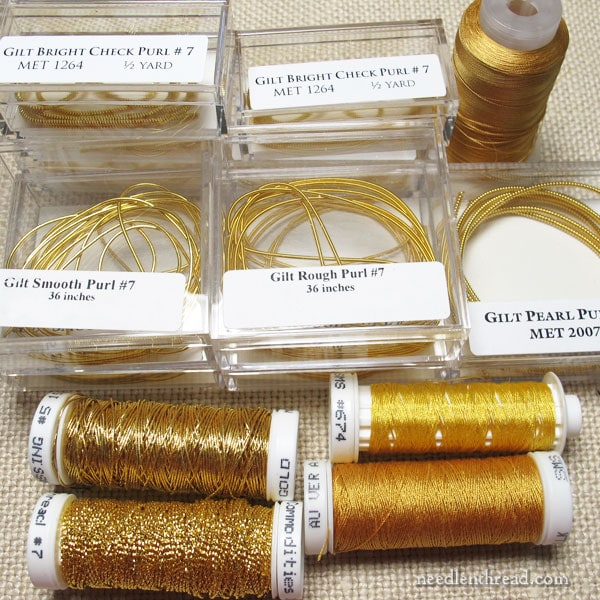
Well, it’s goldwork, after all… so real metal goldwork threads definitely come into the picture!
It’s been a few years since I’ve written about a goldwork project here on Needle ‘n Thread. Since some of you are new to embroidery and to Needle ‘n Thread, and perhaps you’ve not explored much goldwork, I’ll be linking to different background articles that will help clarify the supplies and techniques that I’m talking about as this project progresses.
One thing I really want to clarify while we go through this project: goldwork embroidery is often seen as the “pinnacle” of advanced embroidery techniques and out of reach for beginning and intermediate embroiderers. This is not the case!
While goldwork does require some precision, it is not difficult to do. The difficulty of goldwork lies more in getting ahold of the supplies, setting up the project, and figuring out the differences between metal threads, more than in actually doing the stitching. Most goldwork techniques are as easy as couching down a thread (so, a straight stitch over the top of another thread) and sewing on a bead. If you can do those two things, you can do goldwork!
The Real Metal Threads
Goldwork supplies involve real metal threads as opposed to metallic threads. Real metal threads are generally made from gold alloy (and other metal) wire of various weights.
For this project, I’ve gathered several types of goldwork threads:
- Smooth passing thread – you can read about this thread here and see what it does)
- Check thread – you can read about it here
- Pearl purl – one of my favorite metal threads, and you can read about it here and here
- Purls of various kinds for chip work, which you can read about here
I’m debating about the purls and chip work, but we’ll discuss that below!
Adding Color to the Goldwork
I want a line of color within the goldwork frame, and so I gathered some silk, too!
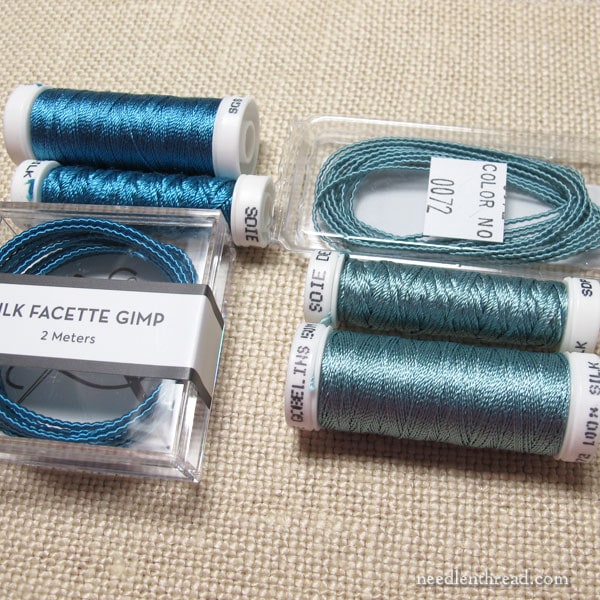
And not just any silk! The wonderful thing about Au Ver a Soie silks is that they have different types of beautiful silk threads that coordinate across all their collections. This means that you can use different types and weights of silk from Au Ver a Soie, all with the same color number, for a perfect match no matter what type of silk you want to use.
So, for this project, I wanted a blue that would coordinate with the figure embroidery going in the middle of the frame. I wanted a heavy line of blue.
And lo! That’s where some fantastic specialty threads come into play!
Specialty Silk Threads
If you look at the photo above, you’ll see a couple packages with squiggly threads in them.
These are “crinkled” silk-wrapped gimp threads, with a wire foundation but an external, rick covering of beautiful flat silk.
These fantastic threads (so many applications!) were initially produced for Thistle Threads, for their 17th century project courses. If you’re interested in them, shop owners can inquire about them through Access Commodities, and the rest of us, through any shop that carries threads from Access Commodities.
Thistle Threads, incidentally, is a swell place for finding these types of specialty silk threads. Besides their use in the 17th century courses, many of them show up in their Frostings boxes, too. The current Frostings boxes are sold out right now, but I’m keeping my fingers crossed for a third installment. They’re a terrific way to build a nice collection of usable, beautiful, high-quality specialty threads that have exciting modern applications.
So, as it works out, I had samples of the silk facette gimp (the darker blue on the left) and the serpentine gimp (the lighter blue squiggly package on the right).
Both would serve my purpose, but I like the more vivid blue (#277 in the Au Ver a Soie silk range) on the left. I decided I’d used the darker blue facette gimp.
Then, I selected an Au Ver a Soie silk thread that would work for couching the gimp invisibly (Soie Gobelin, on the larger spool) and a spool of Soie de Paris that I could use as a color accent in some stretched pearl purl (you can read about that technique here).
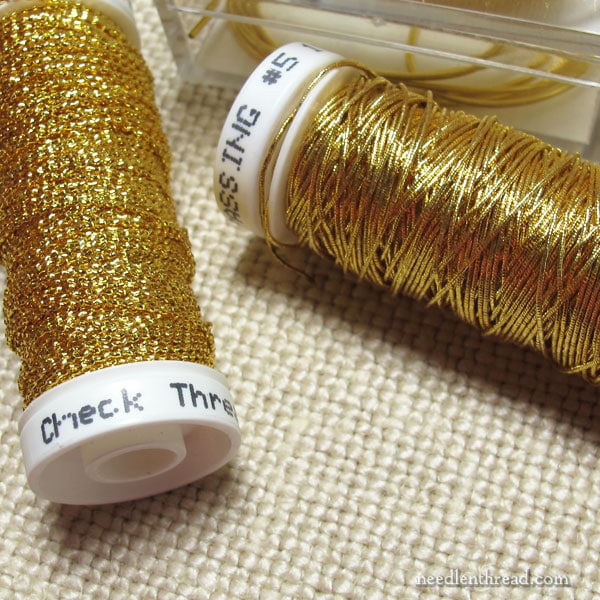
I’m definitely using the smooth passing thread in the photo above (that’s the one on the right), but I’m in a real quandary about the check thread. I don’t know if I’ll use it or not. It’s very sparkly – which I like – but it’s very bright and sparkly, so it might overwhelm the vintage and faded embroidery that’s going inside the frame.
Goldwork Quandary
That’s one of my dilemmas in the planning part of this, and it ties into my overall quandary:
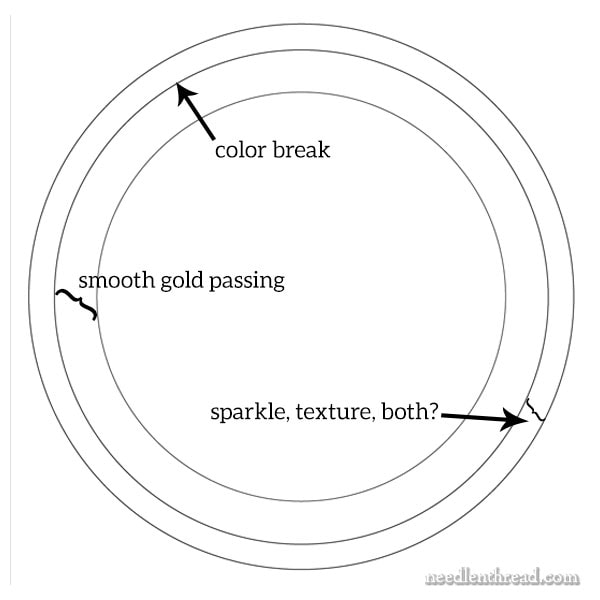
Above, you can see a representation of the frame. It’s an 8″ round frame, 1″ wide. I’m planning to cut the goldwork with a blue line along the off-set line marked “color break” on the diagram above.
The inside of the frame will be couched smooth passing thread.
I’m not sure what to put in the outside section of the frame. The effect I want to achieve is to “lift” that outside section (not necessarily physically, but visually), so that the whole frame ends up having a kind of beveled effect, without being actually beveled.
The inside area of smooth passing will look somewhat flat and very smooth, the color line will create a break in the gold and raise that area where the color break is, somewhat, as the threads are significantly larger than the passing thread. And then the outside rim should look a little brighter, with a little more visual interest.
So I’m debating about chip work there, framed in with some pearl purl on the outer edge, or couching the check thread there.
There are pros and cons to both. But what it all boils down to is what’s going to look best. And that’s why I’m in a quandary!
On the bright side, though, I can start stitching on the parts that I’m sure about, and let my ideas for that outer rim fester a bit.
Any input? I’d love to hear your thoughts! Feel free to chime in below!
Suppliers
Au Ver a Soie Silks
If you’re looking for Au Ver a Soie threads in the US, you can find them here through Needle in a Haystack, or any locally owned needlework shop that carries supplies from Access Commodities.
In Canada, check Traditional Stitches.
Worldwide, you can check the retailers listed on Au Ver a Soie’s website, here.
Goldwork Threads
If you’re looking for goldwork threads in the US, check any locally owned shop that carries supplies from Access Commodities. If they don’t normally carry goldwork supplies, they should be able to special order for you.
In Canada – for a huge variety of goldwork threads and good information on them – check Berlin Embroidery.
In the UK, Golden-Hinde carries a vast supply of metal threads.
In the EU, Jessica Grimm carries a nice supply of goldwork threads in her online shop, here.
In Australia, Alison Cole, of course!


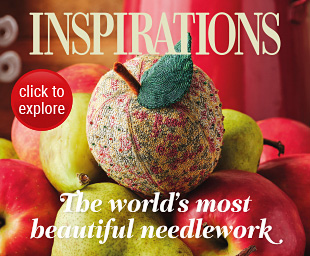
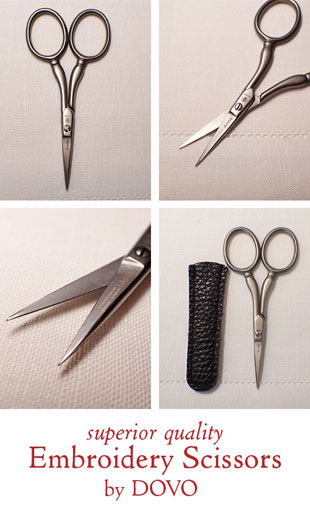

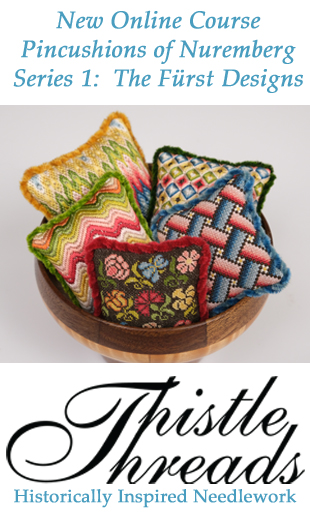

Thanks for mentioning my shop Mary! And I think that your goldwork frame is going to look very pretty. I had never thought of using the gimp as one of my couching threads in with the gold. And since I went shopping where you went shopping, I can replicate :)! Have a nice weekend, Jessica
Hi, Mary! I’m excited to see what you do with your Goldwork project. It will be super fun to see how it’s worked!
Good morning Mary, how exciting to be able to follow another one of your project. I will be in discovery mode because I know nothing about goldwork yet (it is on my wish list) and admittedly I do feel a bit intimidated. I can’t wait to see what you decide to do with the outer rim and why you chose that route! On another topic, here in Canada Traditional Stitches from Calgary is a pure pleasure for shopping online. Janice and her team are extremely helpful and offer great customer service and quite a variety of products. I have yet to try Berlin Embroidery, I am saving it for futur goldwork project.
Thanks for your inspirational project, always a great learning experience.
Have a great weekend!
Have you considered using silver? Re-examining your photos of the piece, a silver band was used on the halos of Our Lady & John. It might be the inverse of what you are looking for, but—to my eye—it gives visual dimension to those areas. I’m not a fan of extra work, although in this case I could be tempted to stitch an “arc” (or two) on a doodle cloth before auditioning in various positions around the salvaged areas. White mat board can be used to focus each “audition wedge”. Its a way to prevent ripping out & you retain samples for future projects. Best wishes. You are lucky to have such an interesting challenge!
I would go with chip work, but I’m partial to it to begin with.
Dear Mary
I like the goldwork you have chosen and I’m sure they will look great on the project. I agree that goldwork is not difficult it just requires some concentration to it. Just to let you know that Sewandso in the UK have a great selection of Au Ver a Soie threads. Good luck with your selection of goldwork and thanks for sharing with us the different types of gold supplies and for the links on how to use the various gold supplies. I hope you have a great weekend.
Regards Anita Simmance
Hi Mary-
Regarding the outer part of the frame for your goldwork piece:
I have not worked with these threads or worked much with goldwork but….I have worked in the jewelry business and I work with color……I have seen a lot of old and new metal mixed together to create new items. (I do tons of embroidery too!)
Can you break up your outer frame by blending the checkered thread in occasionally with your smooth thread? Having worked with old and new metals – the new metal jumps out immediately and draws your attention like a neon sign. If you can tone it down a little by not having an entire border of “here I am – I am new and shiny thread” I think you would achieve what you are looking for.
You will get your “lift” by creating shadow on different levels/areas of your frame. Is there some way you can do that with a limited thread palette? Is there a way to darken your shiny checkered thread without harming or aging it too quickly?
I don’t know if any of this helps
I love reading your emails daily. Thanks for putting a bright spot into my days!
-Phyllis
Yes, in fact, I was thinking if I do chip work in there, I’ll work a combination of the bright check purl with smooth and rough purl, to give a bit more of a subtle, yet still textured, approach…
Since you want it to look beveled, why not pad the outer ring in staggered layers? Then use chip work to cover? Maybe heavy Russian braid to finish the outside edge. Or even a heavy blue gimp.
Could you possibly do some trapunto on the outer ring after you stitch it?
Chip work and pearl purl was exactly what I was thinking of before I got to that bit of our post! Maybe it would make sense to couch pearl purl on both the outer and the inner edge of the outside ring…
I’ll be looking forward to seeing what you do with this!
Dear Mary: You are a blessing. I’ve just read your email on the gold work frame and so appreciate your knowledge, the instruction, and the resources you so freely provide. Thank you. You are a treasure. Keep well. GCS
Dearest Mary : How jolly to see your new digs! Thinking about the outer rim of your goldwork frame I can understand the desire to add a change of texture completely but for me the checque bits might be a little too busy. Perhaps I’d use the checque purl as one might a slightly slanted satin stitch to give a twisted cord look. Can’t remember how wide the outer area is, but I think it would work with the checque or even better plain purl. The glitter from the crinkly bits may be too much for the delicate figure. Thanks buckets for sharing the work. Charlotte
Thank you for letting us know that we don’t have to be too intimidated and we should try goldwork.
Hi Mary,
All your posts about goldwork are very insteresting for me because in Brittany until about1950, folk people were wearing traditional costumes. In my town call Quimper and the villages about, the women dresses were ornated with a lot of gold work as you can see in the site :
http://www.gavroche-pere-et-fils.fr/la-grande-tromenie-de-locronan-edition-2013/
I inherited the wedding dress of my mother in law and I know that some days I am going to repare and complete the whole dress and make a new apron. So you can imagine how much the knowledge you share with us is precious for me and how much I thank you for that.
As the tradition is still vivid in religious occasions and festivals, it is possible to find gold thread and silk thread easily here in the city, in particular at the embroidery school of Pascal Jaouen.
So I am much interested in your project and looking forward of your choice and realisation. But for your quandary I am afraid of beeing of no use because of lack of experience. Stay the same Mary, you are so precious and thank you again for all you give us.
Best regards
Florence (Brittany)
Thank you so much for the link. I really enjoyed looking at all the pictures of the costumes and the countryside.
Regards,
Helen Hicks
Mary, have you considered using a wool felt ring to pad the outer ring of the frame? Or a satin stitch padding to give the outer ring a bit of a lift?
I would choose the purl in the center of the group of the packets of purl couched in multiple circles with a variation of the Burden Stitch starting in the inside of the circle working to the outside. I would not use the check because I Think it would distract from the antique embroidery
Am so looking forward to where you go with this! So many things to consider isn’t there – background fabric, how dominant the middle embroidery will be, if the outside border is too wide and sparkly bright, will it detract from middle embroidery, etc. I will be following with so much interest to see what you decide!
Yes, you’ve covered all the points I’m trying to keep in mind, Patricia! I chose the width (1″) of the frame, based on the typical width of the galloons (the ornamental flat trim) that’s often used on the back of vestments, which is what this piece is for. The galloons are usually 1″ wide, and if the frame is narrower around the central medallion, it would look a little chintzy. Hence, the 1″ frame. We shall see how it all comes together!
As regards your dilemma. One of my favourite techniques is s’ing with purl of ones choice. Would this work as part of your outer frame I wonder? It would certainly give you interest and a physically raised effect. I await development with interest.
S-ing could work in part of it, but it would be narrower than the space, I think. I’d like to fill the space completely with the same technique – but I will keep the idea in mind. It might actually work if I can “widen” the S-ing to cover the whole space. The purls would have to be pretty long. I will definitely think about it!
Thank you Mary for your blogs. I learne so much from them. I can not wait to see the finished gold work project.
Thank you for the supplies link, it is very helpful since most craft and embroidery stores do not exist anymore.
Have a beautiful weekend.
Sophia
This is definitely a project that you (or I, if I were stitching it) would have to make decisions on as you go.
So, yes, I think your best bet is to stitch the “for certains” and figure out the rest after.
Temptation abounds – the third installment of the Frostings series is available now….
My “Fiber Retirement Account” includes
Temptation abounds – the third installment of the Frostings series is available now…
My “fiber retirement account” includes some goldwork threads and projects. Now I just need to figure out how to retire sooner rather than later!
Dear Mary,
This looks like a very interesting project. I enjoy your discussion of choices and the discussion that has followed in the comments.
I particularly appreciate the Au Ver a Soie link as it has given me names of UK suppliers of these threads. Postage costs from abroad are often horrendous; I can seldom justify ordering from the States.
Regards,
Helen
Love the blue threads and wires, you are tempting me to get back into needlework (even just to make a special item for my home), Thanks for sharing and inspiring me.
Thank you so much for mentioning the Canadian suppliers.
We here frequently feel left out of the info loop.